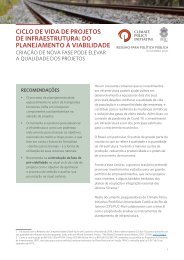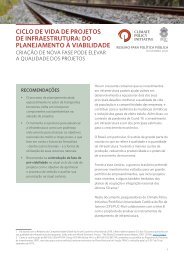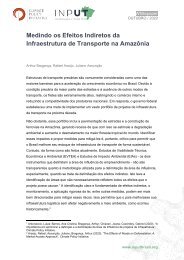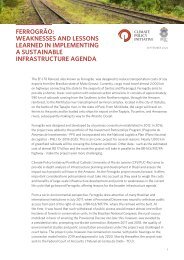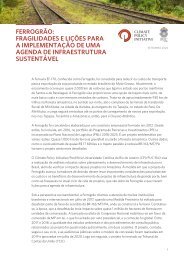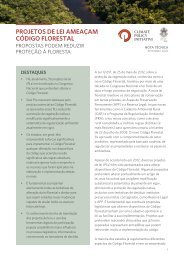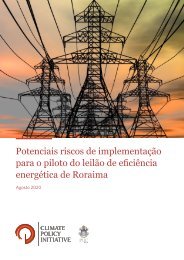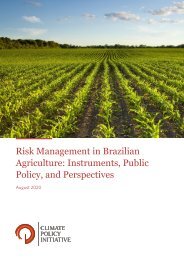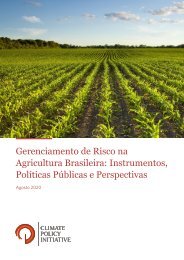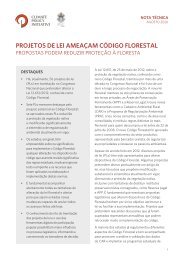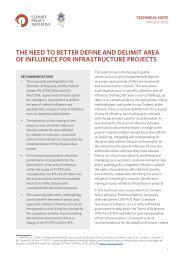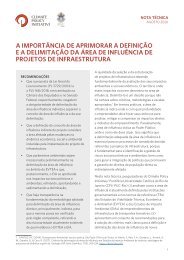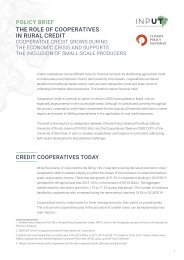The Impacts of Rural Credit on Agricultural Outcomes and Land Use
Create successful ePaper yourself
Turn your PDF publications into a flip-book with our unique Google optimized e-Paper software.
11<br />
CONCLUSION<br />
This policy brief builds <strong>on</strong> previous evidence from CPI/PUC-Rio that shows that rural credit in<br />
Brazil boosts producti<strong>on</strong> <strong>and</strong> crop yields <strong>and</strong> intensifies agricultural producti<strong>on</strong> in such a way that<br />
deforestati<strong>on</strong> pressure decreases. Here, the impacts <str<strong>on</strong>g>of</str<strong>on</strong>g> rural credit are detailed across three relevant<br />
dimensi<strong>on</strong>s: credit lines, types <str<strong>on</strong>g>of</str<strong>on</strong>g> producers, <strong>and</strong> uses for credit.<br />
Results show that the average impacts <str<strong>on</strong>g>of</str<strong>on</strong>g> Brazilian rural credit—with patterns <str<strong>on</strong>g>of</str<strong>on</strong>g> increasing<br />
productivity while reducing deforestati<strong>on</strong>—are more predominant for credit associated with small<br />
farmers. <str<strong>on</strong>g>The</str<strong>on</strong>g> credit for large farmers, while c<strong>on</strong>tributing to increasing producti<strong>on</strong> <strong>and</strong> yields, also leads<br />
to an expansi<strong>on</strong> <str<strong>on</strong>g>of</str<strong>on</strong>g> cropl<strong>and</strong> <strong>and</strong> pastures, resulting in higher deforestati<strong>on</strong>. Moreover, productivity<br />
increases are more relevant for credit associated with small farmers compared to larger farmers.<br />
Policymakers should prioritize small farmers in the rural credit policy to increase producti<strong>on</strong> <strong>and</strong><br />
l<strong>and</strong> productivity <strong>and</strong> mitigate adverse impacts <strong>on</strong> the envir<strong>on</strong>ment. Tailoring the rural credit policy<br />
toward this goal aligns subsidies with forest c<strong>on</strong>servati<strong>on</strong> <strong>and</strong> fits in a scenario in which medium <strong>and</strong><br />
large farmers are more likely to be served by unsubsidized credit, especially in the Brazilian c<strong>on</strong>text <str<strong>on</strong>g>of</str<strong>on</strong>g><br />
lower interest rates. Moreover, since credit for large producers is associated with higher deforestati<strong>on</strong><br />
<strong>and</strong> this group occupies most <str<strong>on</strong>g>of</str<strong>on</strong>g> the country's agricultural l<strong>and</strong>, other instruments <strong>and</strong> policies are<br />
necessary to encourage forest c<strong>on</strong>servati<strong>on</strong>.<br />
AUTHORS<br />
Juliano Assunção<br />
Executive Director<br />
Climate Policy Initiative/P<strong>on</strong>tifical Catholic University<br />
<str<strong>on</strong>g>of</str<strong>on</strong>g> Rio de Janeiro (CPI/PUC-Rio)<br />
Associate Pr<str<strong>on</strong>g>of</str<strong>on</strong>g>essor, Department <str<strong>on</strong>g>of</str<strong>on</strong>g> Ec<strong>on</strong>omics, PUC-Rio<br />
juliano.assuncao@cpirio.org<br />
Priscila Souza<br />
Head <str<strong>on</strong>g>of</str<strong>on</strong>g> Policy Evaluati<strong>on</strong>, Financial Instruments<br />
Climate Policy Initiative/P<strong>on</strong>tifical Catholic University<br />
<str<strong>on</strong>g>of</str<strong>on</strong>g> Rio de Janeiro (CPI/PUC-Rio)<br />
priscila.souza@cpirio.org<br />
Suggested Citati<strong>on</strong><br />
ASSUNÇÃO, Juliano; SOUZA, Priscila. Policy Brief. <str<strong>on</strong>g>The</str<strong>on</strong>g> <str<strong>on</strong>g>Impacts</str<strong>on</strong>g> <str<strong>on</strong>g>of</str<strong>on</strong>g> <str<strong>on</strong>g>Rural</str<strong>on</strong>g> <str<strong>on</strong>g>Credit</str<strong>on</strong>g> <strong>on</strong> <strong>Agricultural</strong> <strong>Outcomes</strong> <strong>and</strong> L<strong>and</strong><br />
<strong>Use</strong>: An Analysis by <str<strong>on</strong>g>Credit</str<strong>on</strong>g> Lines, Producer Types <strong>and</strong> <str<strong>on</strong>g>Credit</str<strong>on</strong>g> <strong>Use</strong>s. Rio de Janeiro: Climate Policy Initiative, 2020.<br />
March 2020<br />
Climate Policy Initiative (CPI) works to improve the most important energy <strong>and</strong> l<strong>and</strong> use policies around the world. We support decisi<strong>on</strong><br />
makers through in-depth analysis <strong>on</strong> what works <strong>and</strong> what does not. CPI’s Brazil program partners with the P<strong>on</strong>tifical Catholic University <str<strong>on</strong>g>of</str<strong>on</strong>g><br />
Rio de Janeiro (PUC-Rio). This work is funded by the World Wild Fund (WWF).<br />
www.climatepolicyinitiative.org<br />
C<strong>on</strong>tent licensed under Creative Comm<strong>on</strong>s Attributi<strong>on</strong> 4.0 Internati<strong>on</strong>al.<br />
<str<strong>on</strong>g>The</str<strong>on</strong>g> texts in this publicati<strong>on</strong> may be reproduced in whole or in part<br />
provided that the source <strong>and</strong> the respective authors are cited.




